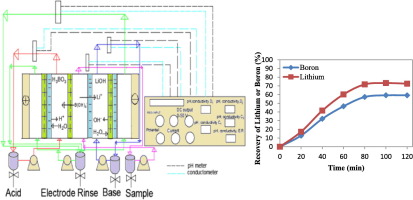当前位置:
X-MOL 学术
›
Desalination
›
论文详情
Our official English website, www.x-mol.net, welcomes your
feedback! (Note: you will need to create a separate account there.)
Application of heterogeneous ion exchange membranes for simultaneous separation and recovery of lithium and boron from aqueous solution with bipolar membrane electrodialysis (EDBM)
Desalination ( IF 8.3 ) Pub Date : 2020-04-01 , DOI: 10.1016/j.desal.2020.114313 Deniz İpekçi , Nalan Kabay , Samuel Bunani , Esra Altıok , Müşerref Arda , Kazuharu Yoshizuka , Syouhei Nishihama
Desalination ( IF 8.3 ) Pub Date : 2020-04-01 , DOI: 10.1016/j.desal.2020.114313 Deniz İpekçi , Nalan Kabay , Samuel Bunani , Esra Altıok , Müşerref Arda , Kazuharu Yoshizuka , Syouhei Nishihama

|
Abstract In this study, heterogeneous ion exchange membranes were tested for separation and recovery of boron and lithium from aqueous solutions with bipolar membrane electrodialysis (EDBM). The results indicated that separation efficiencies and recoveries of both boron and lithium were strongly influenced by the acid and base solutions employed in acid and base cells, flow rate of sample solution and electrical potential applied. It was concluded that separation efficiencies and recoveries of boron and lithium were improved with an increase in the flow rate of sample solution. The highest separation efficiencies were 93% and 69% for lithium and boron, respectively at 50 L/h of sample solution flow rate. The highest recoveries of lithium and boron were achieved as 57% and 41%, respectively at this condition. When electrical potential increased from 15 V to 25 V, boron and lithium separation efficiencies and recoveries obtained were higher. At 30 V of electrical potential, pH of sample solution decreased because of the proton leakage into the sample cell. Since anionic borate ions in sample solution cell were considered to be converted to neutral boric acid, this situation resulted in lower separation efficiencies and recovery of boron from sample solution. By applying optimal process conditions (25 V and 50 L/h of sample solution flow rate), 59% of boron recovery and 73% of lithium recovery were obtained in acid and base cells, respectively.
中文翻译:

异相离子交换膜在双极膜电渗析(EDBM)水溶液中同时分离回收锂和硼的应用
摘要 在这项研究中,测试了非均相离子交换膜通过双极膜电渗析 (EDBM) 从水溶液中分离和回收硼和锂。结果表明,硼和锂的分离效率和回收率受酸和碱电池中使用的酸和碱溶液、样品溶液的流速和施加的电势的强烈影响。结论是硼和锂的分离效率和回收率随着样品溶液流速的增加而提高。在 50 L/h 的样品溶液流速下,锂和硼的最高分离效率分别为 93% 和 69%。在此条件下,锂和硼的最高回收率分别为 57% 和 41%。当电位从 15 V 增加到 25 V 时,硼和锂的分离效率和回收率更高。在 30 V 的电势下,由于质子泄漏到样品池中,样品溶液的 pH 值降低。由于样品溶液池中的阴离子硼酸盐离子被认为转化为中性硼酸,这种情况导致较低的分离效率和样品溶液中硼的回收率。通过应用最佳工艺条件(25 V 和 50 L/h 的样品溶液流速),酸和碱电池分别获得了 59% 的硼回收率和 73% 的锂回收率。由于样品溶液池中的阴离子硼酸盐离子被认为转化为中性硼酸,这种情况导致较低的分离效率和样品溶液中硼的回收率。通过应用最佳工艺条件(25 V 和 50 L/h 的样品溶液流速),酸和碱电池分别获得了 59% 的硼回收率和 73% 的锂回收率。由于样品溶液池中的阴离子硼酸盐离子被认为转化为中性硼酸,这种情况导致较低的分离效率和样品溶液中硼的回收率。通过应用最佳工艺条件(25 V 和 50 L/h 的样品溶液流速),酸和碱电池分别获得了 59% 的硼回收率和 73% 的锂回收率。
更新日期:2020-04-01
中文翻译:

异相离子交换膜在双极膜电渗析(EDBM)水溶液中同时分离回收锂和硼的应用
摘要 在这项研究中,测试了非均相离子交换膜通过双极膜电渗析 (EDBM) 从水溶液中分离和回收硼和锂。结果表明,硼和锂的分离效率和回收率受酸和碱电池中使用的酸和碱溶液、样品溶液的流速和施加的电势的强烈影响。结论是硼和锂的分离效率和回收率随着样品溶液流速的增加而提高。在 50 L/h 的样品溶液流速下,锂和硼的最高分离效率分别为 93% 和 69%。在此条件下,锂和硼的最高回收率分别为 57% 和 41%。当电位从 15 V 增加到 25 V 时,硼和锂的分离效率和回收率更高。在 30 V 的电势下,由于质子泄漏到样品池中,样品溶液的 pH 值降低。由于样品溶液池中的阴离子硼酸盐离子被认为转化为中性硼酸,这种情况导致较低的分离效率和样品溶液中硼的回收率。通过应用最佳工艺条件(25 V 和 50 L/h 的样品溶液流速),酸和碱电池分别获得了 59% 的硼回收率和 73% 的锂回收率。由于样品溶液池中的阴离子硼酸盐离子被认为转化为中性硼酸,这种情况导致较低的分离效率和样品溶液中硼的回收率。通过应用最佳工艺条件(25 V 和 50 L/h 的样品溶液流速),酸和碱电池分别获得了 59% 的硼回收率和 73% 的锂回收率。由于样品溶液池中的阴离子硼酸盐离子被认为转化为中性硼酸,这种情况导致较低的分离效率和样品溶液中硼的回收率。通过应用最佳工艺条件(25 V 和 50 L/h 的样品溶液流速),酸和碱电池分别获得了 59% 的硼回收率和 73% 的锂回收率。











































 京公网安备 11010802027423号
京公网安备 11010802027423号